In olden days designing process can be done by fixing bare copper wires and electrical and electronic components
to a wooden board and soldered to them. In some cases a schematic
diagram was first drawn on a paper and pasted on the board for placing
the components. The required components were placed over their symbols
on the paper which is glued to the board. Breadboards have developed
over time and used for all types of sample electronic devices. For
instance, The breadboard circuits which are commonly used today is
generally designed with white plastic material and it is a pluggable
board. Electronic breadboard was designed by Ronald J in the year 1971.
Generally, success in early projects
plays a vital role in the career of electronics professionals and
engineering students. Many students quit electronics because they fail
in their first attempt of their electronic projects circuits.
After a few disappointments, student has a misconception that
electronic projects working nowadays might not work properly tomorrow.
Therefore, I recommend beginners start with those projects on breadboard
which will work or not in your first attempt Before you proceed, you
must know how to use a breadboard device. If you don’t know the idea
about the breadboard, then here is the article which gives the various
steps in building a project on bread board.

Steps to Build a Project on Breadboard
What is Breadboard?
The name of the breadboard comes from
the early days of electronics, when people would exactly drive screws
into boards on which they cut board in order to place the components. A
breadboard is made with a plastic material in a rectangular shape with a
huge number of tiny holes. These holes let you simply place an electronic components
to build an electronic circuit which is assembled with various
components. The connections on the breadboard are not stable, so it is
very simple to remove a component if you make a wrong connection.
Breadboards are very great for beginners who are new to electronics. By
using this, you can make different fun electronic projects.
Don’t Miss: A Brief on Bread board Basics and Conenctions
Steps to Building a Project on Breadboard Circuit
Breadboard is used to design various electrical and electronic projects
in less time without soldering.But in the field of electronics, there
are many students or beginners are facing lot of problems. Because, they
cannot solder the components cleanly on PCBs (printed circuit boards).
The joint of one bad solder can cause the project damage. When the
project doesn’t work properly, they generally lose their confidence and
stop to continue designing projects.
Current breadboard circuits are designed
with a plastic material, and available in different sizes, shapes and
colors. Generally, the most common sizes you will see are mini size,
half size and full size bread board. Some bread breadboards are designed
with notches and tabs on the sides of the board that let you snap
several boards composed. But, a single half-sized breadboard is enough
for numerous basic level projects.
Step1: Know the Working of the Breadboard
The diagram of the breadboard circuit is
shown below and the horizontal and vertical connections of the
breadboard are represented by red lines. The upper and lower parts of
the breadboard are equal and have 4-horizontal connecting strips. The
middle part of the breadboard has vertical connecting strips divided by a
horizontal channel in the middle. Each connecting strip is electrically
isolated with other strip. The lead of the any component can be plugged
into a hole of the board.
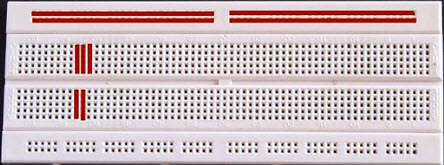
Breadboard Connections
Step2: Analyze the Circuit Diagram
For instance, here we have taken
automatic dark detector circuit diagram. The circuit connections are
shown below and transforming a circuit onto a breadboard layout is not
transforming a circuit diagram to a breadboard layout is not direct
because, the connections of components on breadboard appear quite
different from the above circuit. Before placing components on
breadboard circuit, you should concentrate on their connections, not
their locations on the circuit diagram. A breadboard circuit is used to
test electronic projects and the components which are used on the
breadboard can be reused for other projects.
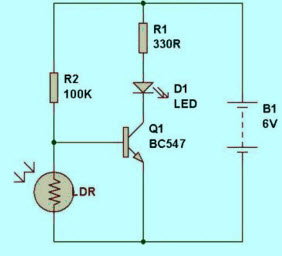
Automatic Dark Detector
Step 3: Get the Required Components
The components which have long metal
legs those are compatible with the breadboard circuits. Sometimes,
shorter metal legs also fit with the board. The electrical and
electronic components of the dark detector circuit mainly include: NPN Transistor (BC548,
BC147, BC547), 100K and 330Ohm resistors, LED (Light emitting diode),
LDR (Light dependent resistor), 0.6mm diameter single core plastic
connecting wire and 9V battery.
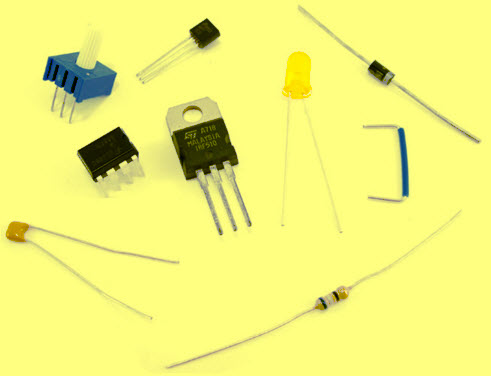
Electronic Components
Step 4: Insert the Components on Breadboard
Get the components which are required
for the above schematic diagram and give the connections on the
breadboard circuit according to the circuit diagram.The interconnections
between these components can be done by using connecting wires.
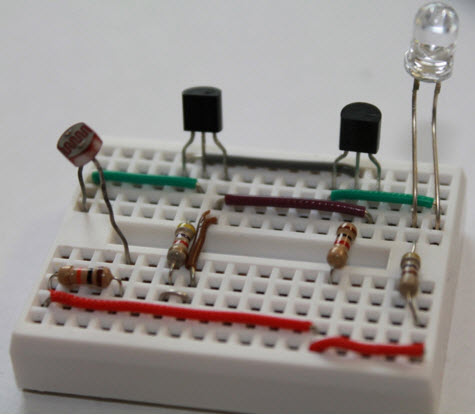
Dark Sensor Connections on Breadboard
Step 5: Give the Power Supply
Finally, give the power supply to the breadboard board
circuit using a positive and negative terminals of the battery. If you
connect the battery in the wrong way, then they won’t give the supply to
the breadboard and reverse polarity of the battery on the board may
damage, so make sure to connect the battery in the right way.
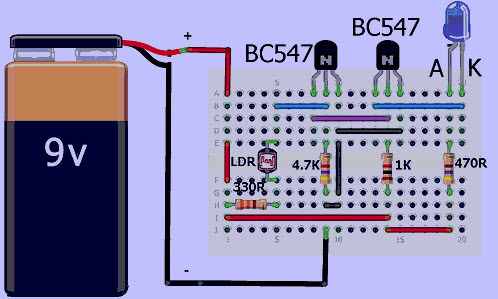
Connections of Dark Sensor Circuit
Thus, this is all about the various
steps to building a project on the breadboard circuit. We hope that you
have got a useful information. Furthermore, any queries regarding this
concept or electronics projects,
please give your feedback by commenting in the comment section below.
Here is a question or you, what is the difference between active and
passive components?
Photo Credits:
- Working of Breadboard startingelectronics
- Automatic Dark Detector Circuit buildcircuit
- Components on Breadboard staticflickr






No comments:
Post a Comment